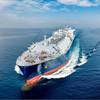Mega Ships and Cyber Attacks Pose New Threats
Shipping losses continued their long-term downward trend with 75 reported worldwide in 2014, making it the safest year in shipping for 10 years, according to Allianz Global Corporate & Specialty SE’s (AGCS) third annual Safety and Shipping Review 2015, which analyzes reported shipping losses of over 100 gross tons.
Shipping Losses Continue to Decline
Losses declined by 32% compared with the previous year and were well below the 10-year loss average of 127. Since 2005 shipping losses have declined by 50%. More than a third of 2014’s total losses were in two maritime regions: South China, Indo China, Indonesia and the Philippines (17 ships) and Japan, Korea and North China (12 ships). Cargo and fishing vessels accounted for over 50% of all losses.
The most common cause of total losses is foundering (sinking/submerging), accounting for 65% of losses in 2014 (49). With 13 ships wrecked or stranded, grounding was the second most common cause with fires/explosions (4) third, but significantly down year-on-year.
Regional Comparisons
There were 2,773 shipping incidents (casualties) globally (including total losses) during 2014. The East Mediterranean & Black Sea region was the top hotspot (490), up 5% year-on-year. The British Isles, North Sea, English Channel and Bay of Biscay ranked second (465), up 29%, and was also the top incident hotspot over the past decade.
The U.S. eastern seaboard region did not register a total loss during 2014, the second successive year this has occurred. It has incurred 14 losses between 2005 and 2014. The North American west coast region also did not see a total loss during 2014. There have been 17 total losses here over the past decade. There have been 783 shipping incidents (casualties) in the North American west coast region since 2005 – the 10th highest overall globally, just behind the Gulf of Mexico (806).
Passenger ship safety and crew levels in the spotlight
While the long-term downward trend in shipping losses is encouraging, recent casualties such as Sewol and Norman Atlantic have once again raised significant concerns over training and emergency preparedness on passenger ships three years after the Costa Concordia disaster. Seven passenger ships were lost during 2014, accounting for almost 10% of total losses.
“In many cases, construction of the vessel is not the only weak point. These two incidents underline a worrying gap in crew training when it comes to emergency operations on ferries or passenger ships,” says Captain Andrew Kinsey, Senior Marine Risk Consultant, AGCS.
The general shipping trend for smaller crews means seafarers are being asked to do more with less. Minimum manning levels reduce the ability to train people onboard, which can provide invaluable insight and should not become the normal day-to-day level for safe operations.
How big is teu big?
Container ship safety is also under the spotlight with ever-increasing ship sizes, as evidenced by the January 2015 inauguration of the world’s largest container ship, the MSC Oscar(19,224 teu). The length of four football pitches, it can carry 19,000 containers. Yet ships as large as 22,000 teu are expected to be in service soon.
“Larger ships can also mean larger losses. The industry should prepare for a loss exceeding $1billion in future featuring a container vessel or even a specialized floating offshore facility,” Kinsey said. Maximum exposure would not necessarily be limited to vessel and cargo value but could also include environmental or business interruption backlash.
AGCS sees a number of risks for such mega-ships, including:
- Limited number of deep water ports that can operate such vessels, leading to an increased concentration of risk;
- World-wide shortage of qualified seaman;
- Salvage and removal challenges.
Port and ships become hacker targets
Protection against cyber risks is another new threat for a shipping sector, which is highly interconnected and increasingly reliant on automation. “A cyber-attack targeting technology on board, in particular electronic navigation systems, could possibly lead to a total loss or even involve several vessels from one company,” said Kinsey. Other scenarios include cyber criminals targeting a major port, closing terminals, or interfering with containers or confidential data. Such attacks could also result in significant business interruption costs, notwithstanding liability or reputational losses.
Polar Code welcomed, but need for constant revision
The shipping industry has welcomed the recent arrival of the Polar Code, which aims to curb risks from increased traffic in the Arctic and Antarctica. Analysis shows there were 55 reported shipping incidents in Arctic Circle waters during 2014, including one total loss. There were just three in 2005. While the code addresses many safety issues, questions remain, particularly around crew training, vessel suitability and potential clean-up.
Further risk challenges
- Overreliance on electronic navigation: The collision of the cargo ship Rickmers Dubai with an unmanned crane barge in 2014 is an example of the perils of overreliance on e-navigation. Training standards around systems such as Electronic Chart Display and Information Systems (ECDIS) are mixed. “Officers need robust training in order to avoid misinterpretation of ECDIS and operating mistakes that could lead to expensive disasters. Beyond that manual navigation aids and skills are still crucial,” says Kinsey.
- Rise in geopolitical uncertainty: The recent rise in geo-political tension has led to an increase in human trafficking of refugees by sea, creating search and rescue issues. More than 207,000 migrants crossed the Mediterranean in 2014, driven by the civil war in Syria. The International Maritime Organization estimates at least 600 merchant ships were diverted in 2014 to rescue people, stretching resources and rescue infrastructure. Conflicts in the Middle East also put increasing pressure on the supply chain.
- Piracy risks move from Africa to Asia: Although there has been good progress tackling activity in Somalia and the Gulf of Guinea, ensuring global attacks (245[1]) are down for a fourth year in a row, piracy thrives elsewhere. Attacks in South East Asian waters are up year-on-year, as are incidents in the Indian subcontinent, with Bangladesh a new hotspot.









